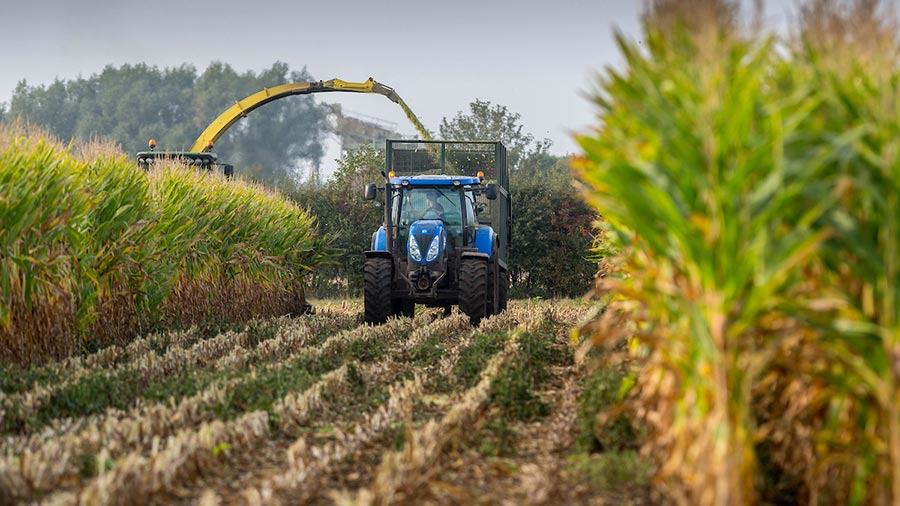Maize Watch: Crops perform well despite challenging weather
 © Tim Scrivener
© Tim Scrivener Maize has done well in this year’s challenging weather conditions, utilising summer rain for excellent plant growth, reports Neil Groom, manager of forage specialists Grainseed.
“Spring was wet and maize drilling delayed in many areas well into May since field conditions were too wet to cultivate.
“Many growers were patient and produced good seedbeds and seedling emergence was rapid in the warm May soils,” he says.
“June heat suited the maize plants and also held back weed growth as it was scorching hot.
“We were just thinking “I hope it rains soon” when the jet stream moved south and we had weeks of heavy showers and warm nights – ideal for maize.”
See also: How a maize crop hit 57t/ha fresh weight despite drought
Last weekend’s high temperatures are helping rapid starch lay down in the grains and Neil thinks crop dry matters (DM) are likely to increase faster than the commonplace 2% per week.
With warm and windy weather in September he says DM can rise by 4-5%, so fields should be checked twice a week.
John Hancock who farms in Sussex is sampling his maize for Farmers Weekly: “I irrigated all my maize before flowering and have good yields.
“The cobs are well-filled and I am planning to cut next week as the crop will rapidly mature on my greensand soils.
“I cut 100t 10 days ago so that we could mix fresh maize into the ration with the residue of last year’s crop and this has been feeding well.”
The irrigated field had 37.5mm of water in late June and again in mid July. The harvester was recording 48t/ha at 30% DM.
At the far end of the field where there was no irrigation, the yield was 25t/ha and DM 37%.
Progress of maize crops on six sites across Britain 2023 growing season |
||||
| Site | Drill date | Height above sea level (m) | Crop dry matter 5 September | Increase from last week |
| Petworth, Sussex | 7 May | 50 | 29.2% | |
| Harleston, Norfolk | 18 May | 30 | 20.7% | |
| Crediton, Devon | 22 April | 118 | 28.4% | |
| Ticknall, Derbyshire | 8 May | 67 | 25.4% | |
| Narbeth, South Wales | 4 May | 32 | No sample yet | |
| SRUC, Dumfries, Scotland SAMCO Film | 45 | 26.7% | ||
| SRUC, Dumfries, Scotland Conventional | 45 | No sample yet | ||
| Source: Grainseed Variety grown: Faith. Variety grown under film: Palladium. | ||||
How to assess grain maturity
- Assess plants in several parts of the field away from the headland
- Open up six cobs in a row to observe cob fill and grain maturity
- Crack the cob in half and squeeze the base of the grains to determine grain moisture levels
- The grain will go through the milky stage, to cheesy ripe, then hard and mature when only the smallest drop of moisture can be squeezed out
Clamp management
When the first loads of silage come into the clamp, check you are happy with the chop length and that all grains have been processed.
Typically aim for 18-20mm to provide some rumen scratch factor.
Load the clamp in thin layers and keep rolling continuously to exclude all of the air. When clamp space allows, have another tractor rolling the clamp alongside the buckrake.
You need 25% of the delivery rate on top rolling, so if you have six trailers weighing 15t every hour, you need 22.5t of kit rolling on top.
Reseeding after maize harvest
An early maize harvest allows you to reseed grass leys throughout September or drill a catch crop of Westerwolds ryegrasses, Italian ryegrasses or grazing rye.
These will allow you to get stock out grazing early in spring and reduce winter feeding pressures.
With the dry soil conditions, these seeds can be sown with a grass harrow and rolled in.
The young grass will utilise any residual nutrients, help reduce soil erosion and maintain soil structure over winter.
